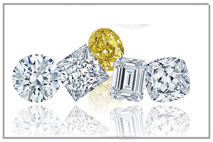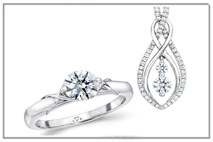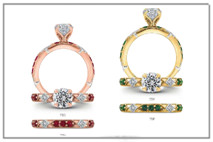To Have and to Hold… Maybe
 Once evergreen, the wedding market is facing some challenges as evident by the bankrupt bridal gown company Alfred Angelo and struggling David’s Bridal. According to Unity Marketing, the wedding market hit the skids during the recession and never recovered.
Once evergreen, the wedding market is facing some challenges as evident by the bankrupt bridal gown company Alfred Angelo and struggling David’s Bridal. According to Unity Marketing, the wedding market hit the skids during the recession and never recovered.
With a total market size of $72 billion in the U.S., young couples today are just not buying into marriage like they used to, despite the fact that the millennial generation is the largest in history. If they were following historic traditions, it would translate into a thriving wedding market, points out Pam Danziger, president of Stevens, Pennsylvania based luxury market research firm.
But in fact, the rate of marriage is declining from 8.2 marriages per 1,000 in 2000 to 6.9 in 2016, finds the CDC/NCHS National Vital Statistics. Millennials are delaying marriage until later in life, now 29.5 years for men and 27.4 years for women, but at 92 million strong the generation spans 18-38 years of age and should be bolstering the wedding economy despite the lag in the age of marriage.
Danziger cites a new study from James Allen, online Diamond Jewelry Retailer and Signet Jewelers Limited brand that suggests a wedding is a luxury most Millennials cannot afford. The Knot cites the average cost exceeding $35,000, compelling couples to create extravagant wedding experiences to make their day memorable for themselves and guests. Thirty percent of newly married couples surveyed said they delayed wedding plans due to the heavy financial burden of putting one on. This compares to only 8% of couples a decade ago, when Conde Nast Bridal group estimated the cost of a wedding was $28,000.
Young people don’t see the benefits of marriage in the same way as previous generations. In a Pew Research Center study over two-thirds of Millennials, ages 18 to 29 said that society is just as well off if people have priorities other than marriage and children. Today, 50% of adults are married, on a steady decline since 1960 when it was 72%, dropping to 54% in 2000. Being single is an accepted lifestyle choice for more Americans. While nearly 60% of singles surveyed said they hope to get married someday, 40% are on the fence.
People Not Product
Rebecca Foerster, executive vice president of strategic planning and marketing, Leo Schachter Diamonds, New York stresses the need for jewelers to shift from product to people. It’s about positioning diamonds and jewelry as the ideal symbol of what is rare and precious like the special relationships we share.
stresses the need for jewelers to shift from product to people. It’s about positioning diamonds and jewelry as the ideal symbol of what is rare and precious like the special relationships we share.
Research conducted for the Diamond Producers Association finds that Millennials like diamonds, but not the way the industry talks to them about diamonds. DPA advocates jewelers identify life moments to celebrate with gifts of diamond jewelry, connecting on an emotional level.
Important is the story behind the product and customers having the ability to influence it, says Foerster. Personalization of designs, co-creation, and finding ways to relate the diamond to a personal reason for gifting rather than a marketed one are crucial. She encourages jewelers to create beautiful displays, visual storyboards, and short video clips exploring Behind the Scenes and How-Tos. “What doesn’t work is a hard sell and self-endorsement.”
Room to Grow
 While there is a focus on first time Millennial couples, there are other opportunities to expand the wedding market. Don’t forget encore brides and grooms, those back at it multiple times. The U.S. National Center for Health Statistics, more than four out of 10 weddings in America involve an encore marriage for the bride, groom or both.
While there is a focus on first time Millennial couples, there are other opportunities to expand the wedding market. Don’t forget encore brides and grooms, those back at it multiple times. The U.S. National Center for Health Statistics, more than four out of 10 weddings in America involve an encore marriage for the bride, groom or both.
Neil Shah for Shah Luxury, New York, says encore brides are more likely to break with tradition, have more color, and a custom design. He suggests trained sales associates to understand what they are selling, to ask the right questions, listen to customers, and to guide them in finding the perfect products that best reflect their lifestyles and life moments.
Moreover, same-sex couples are navigating their own takes on longstanding traditions and are eager to partner with pros that are equality minded, finds The Knot’s LGBTQ Weddings Study 2017 with Q.Digital. They’re seeking out wedding vendors that openly show support for same-sex marriage through language or photos on their websites, marketing or The Knot Marketplace profiles.
Most LGBTQ couples (91% women, 88% men) agree that vendors should clearly communicate they’re LGBTQ friendly, with over 90% more likely to shop a vendor that caters to the LGBTQ community. In the study, 17% of female couples and 11% of male proposed to one another. Women (86%) are more likely than men (60%) to exchange engagement rings. One in four created a custom-designed ring and the average spend for women is $3,185, while men spend $2,226.
Regardless of sexual orientation or whether it’s the first or fourth time marrying—couples want a personalized celebration—that’s the top priority for all couples planning their wedding.










